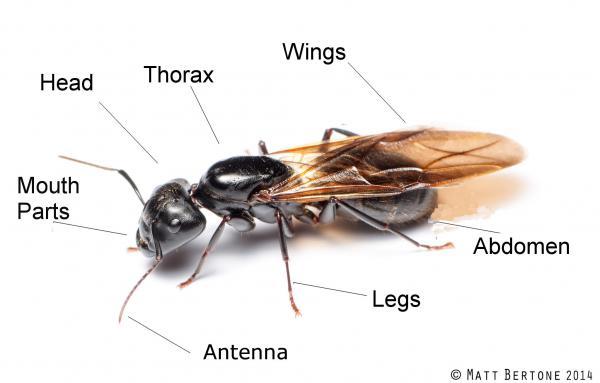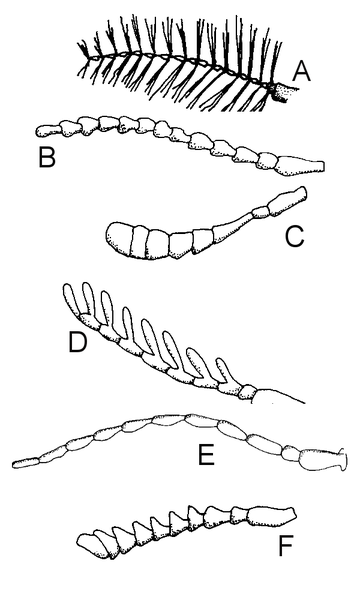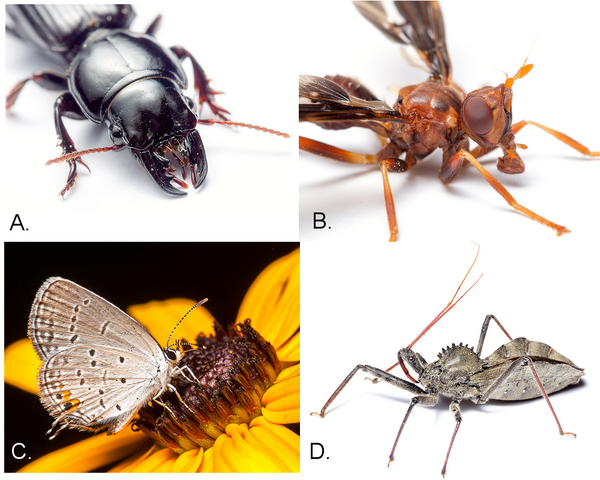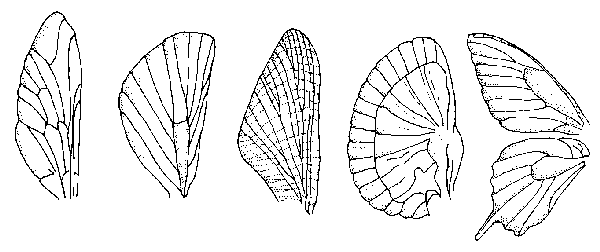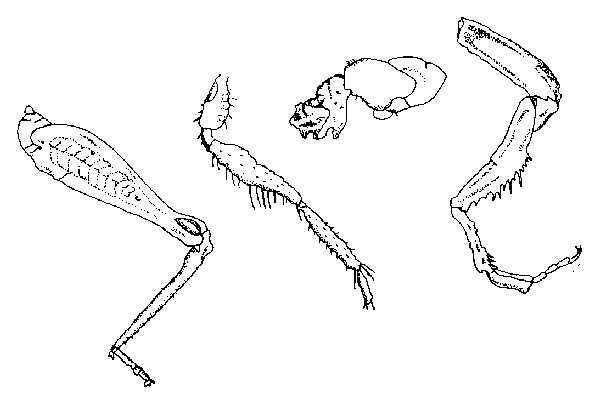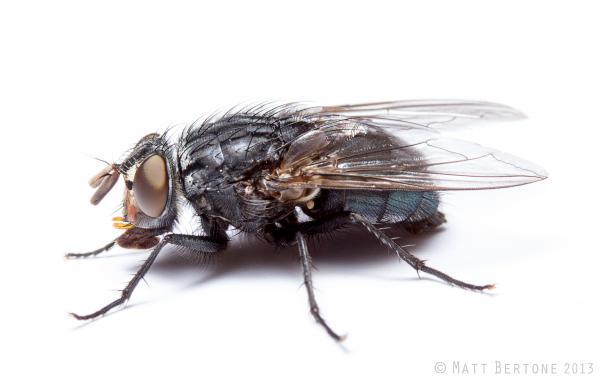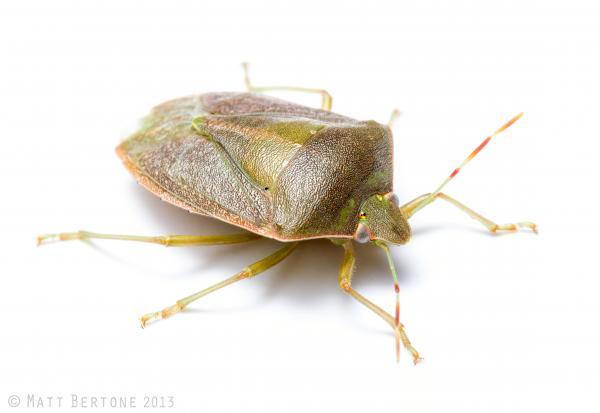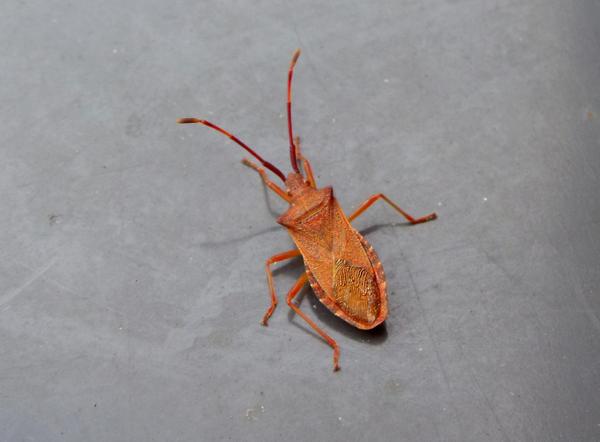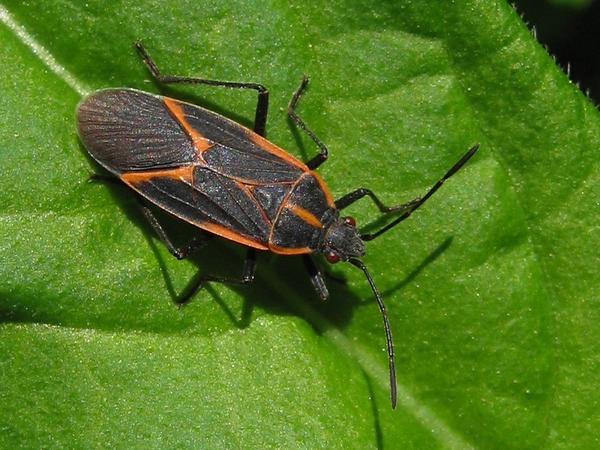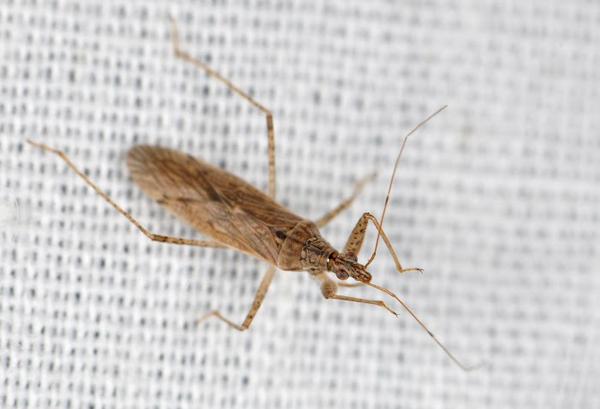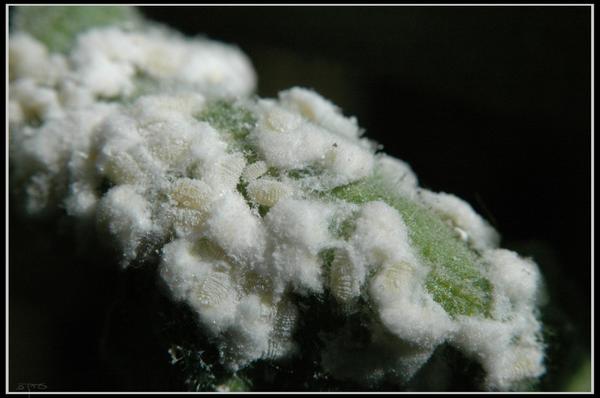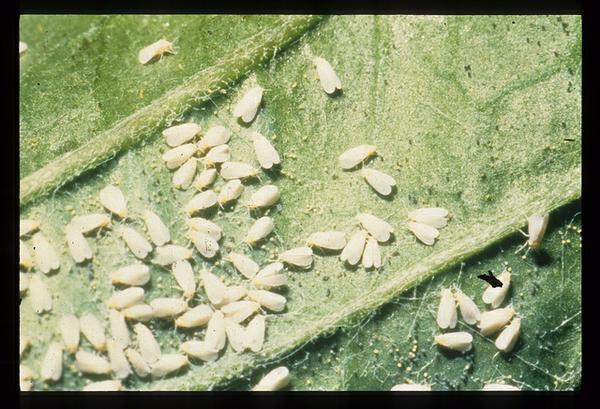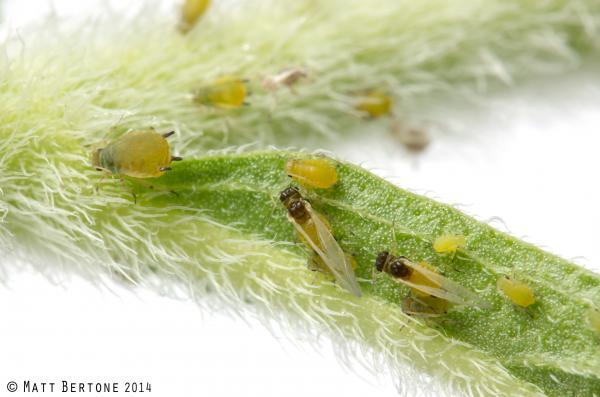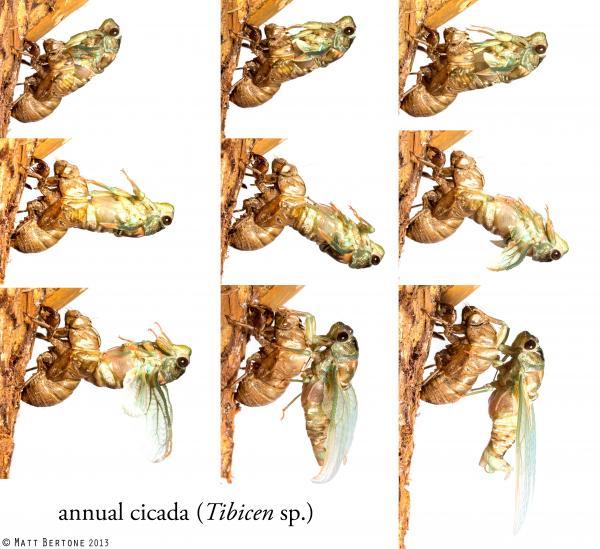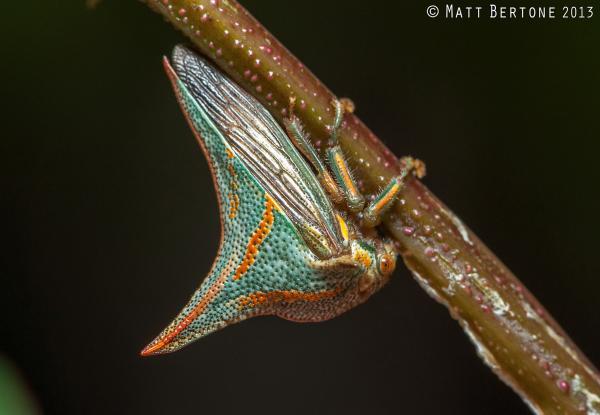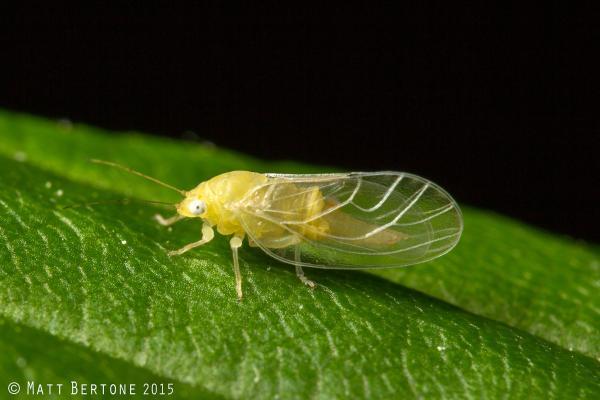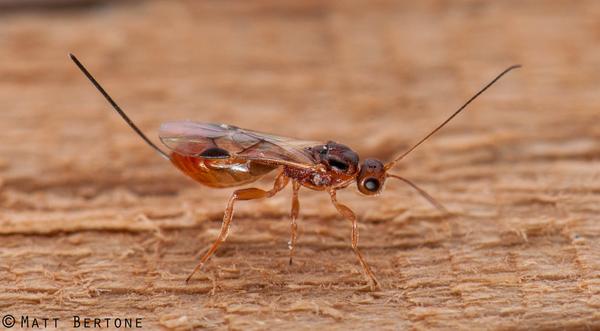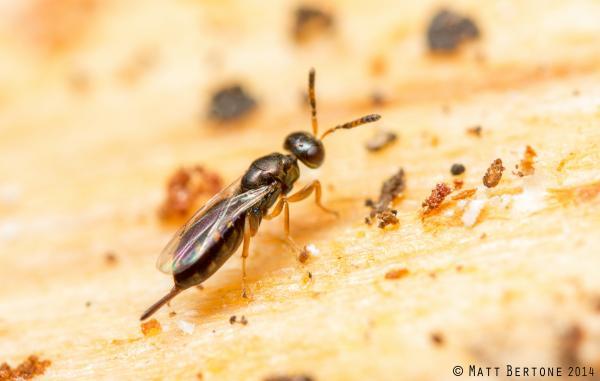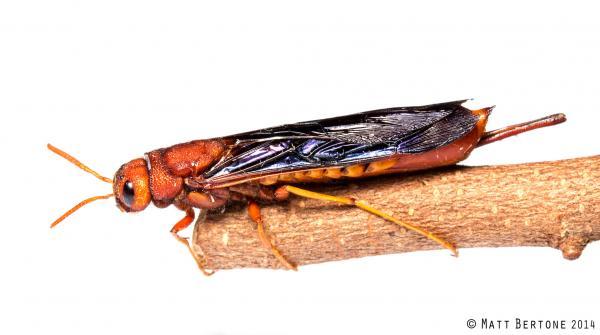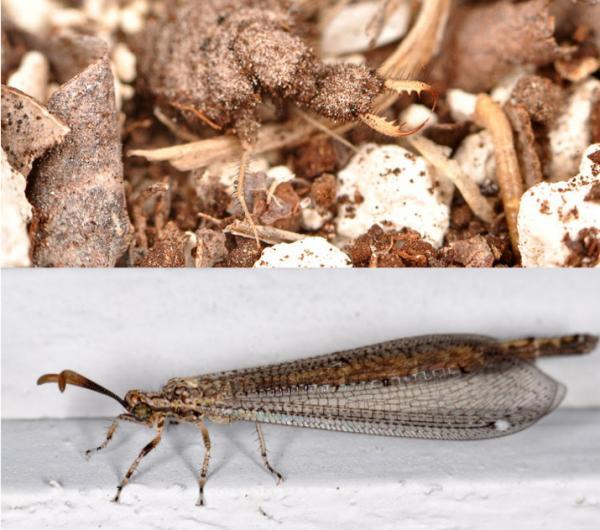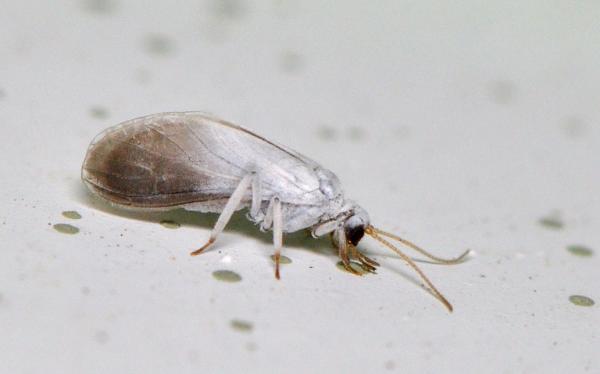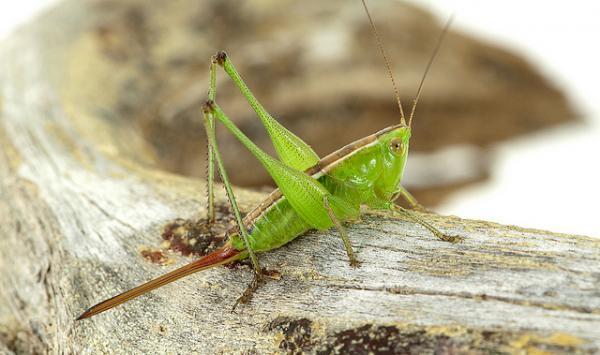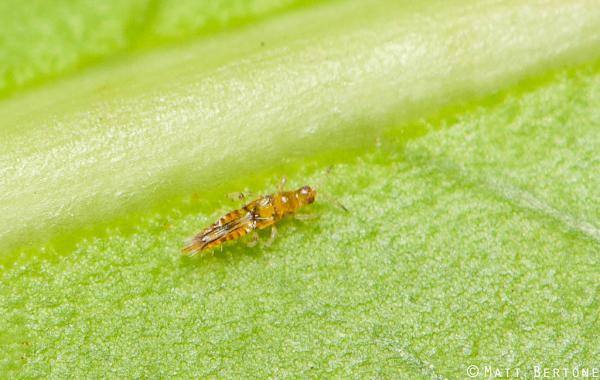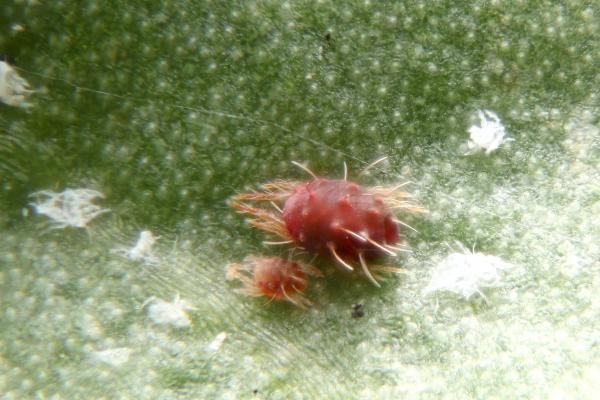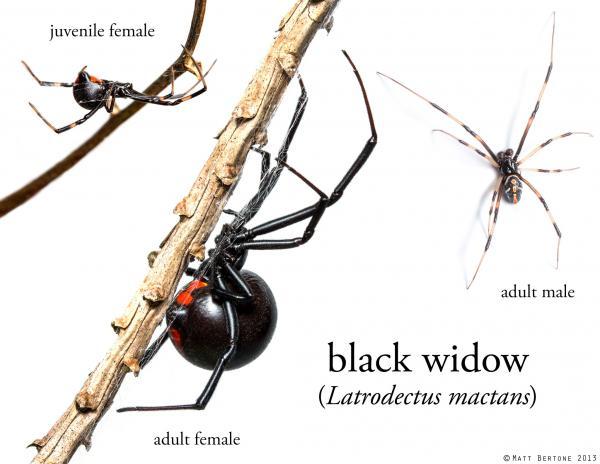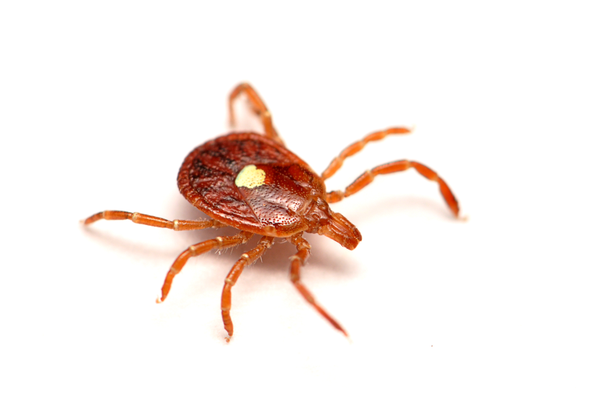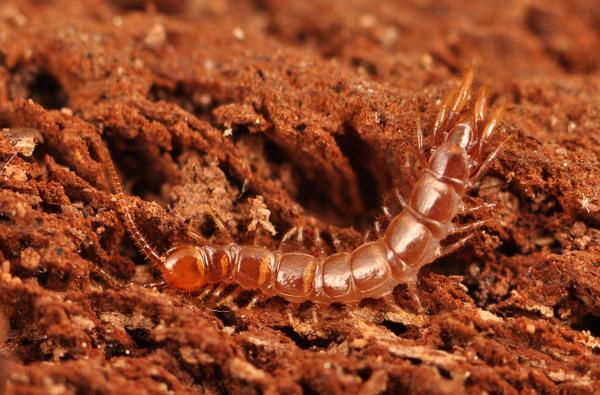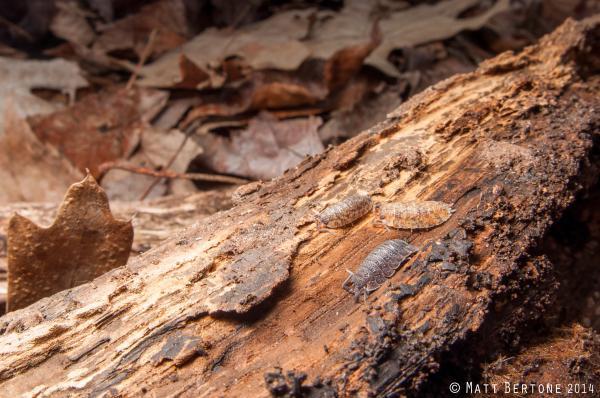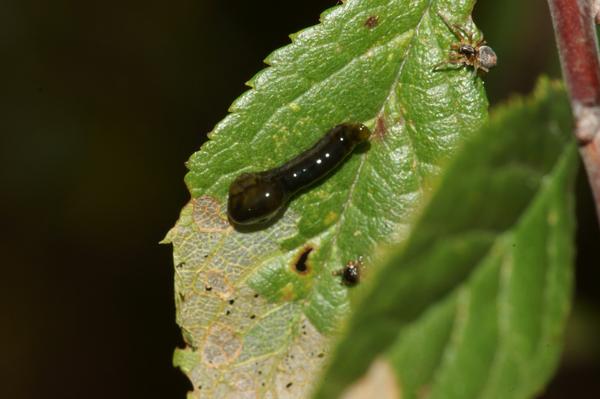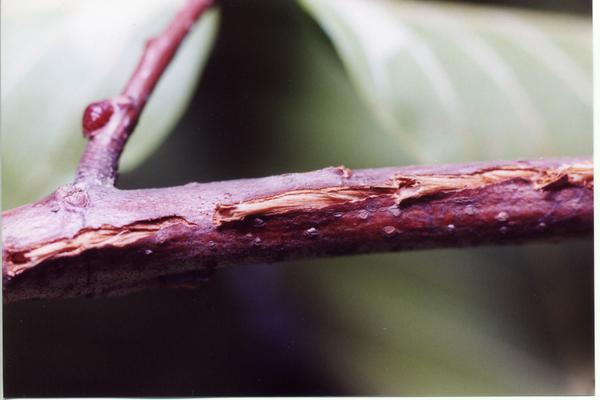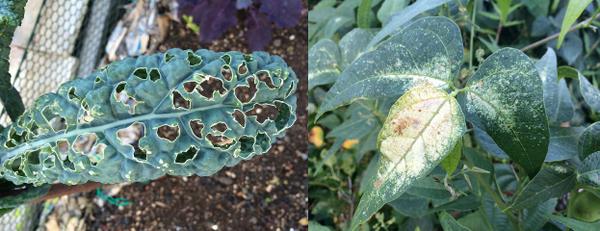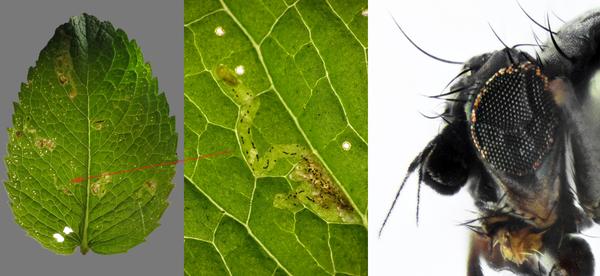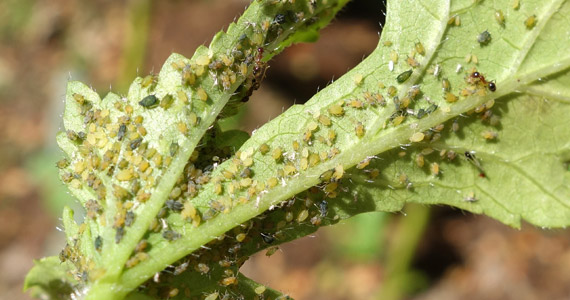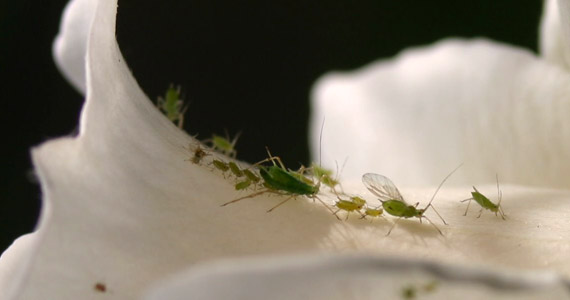Introduction
Insects thrive in more environments than any other group of animals. They live in the air, on and in the soil, and in water. Insects and mites are among the oldest and most numerous animals on earth, with an estimated 100,000 different insect species in North America alone. A typical backyard contains 1,000 or more different insect species. Some estimates say there are 10 quintillion (10,000,000,000,000,000,000) individual insects on earth at any given time. That means there are approximately 300 pounds of insects for every human pound. With that many insects, how is it possible for plants and animals to survive? The vast majority of insects are harmless or even beneficial; less than 1% are considered pests.
For example:
- Insects aid in the production of fruits, seeds, and vegetables by pollinating blossoms. Seventy-five percent of the world’s crops (for food, beverages, fiber, medicine, and spices) and up to 30% of the American diet are the direct result of insect pollination, including many fruits (such as apples, blueberries, and raspberries) and vegetables (such as melons, peppers, and squash).
- Insects improve the soil’s physical condition by burrowing throughout the surface layer. The dead bodies and droppings of insects serve as fertilizer.
- Insects consume dead plant matter, joining fungi and bacteria in recycling waste in our environment.
- Insects are valuable scavengers, devouring the bodies of dead animals and burying carcasses and dung (animal waste).
- Some insects parasitize or prey on harmful insects.
- Some insects are important as feeders on weed plants and seeds, helping to keep populations low.
- Insects serve as food sources for birds, fish, mammals, reptiles, and other animals.
- Some insects produce products humans use, such as honey, wax, silk, and dyes.
- Many insects such as butterflies and beetles can add beauty to a garden.
This chapter covers insects’ biological structure, insect life cycles, insect classification, non-insect arthropods, strategies for identifying insect problems, symptoms and signs of plant damage caused by insects, the cultural and biological management of insects, and beneficial insects relevant to horticultural plants in North Carolina.
Insect Structures
Adult insects have an exoskeleton, three body regions, three pairs of legs, one pair of antennae, and zero to two pairs of wings. Because legs and other appendages vary greatly to suit the insect’s environment, they are often used to classify insects. Immature insects lack wings.
Exoskeleton
Unlike humans, insects do not have bones or a skeleton but rather a tough outer body wall, called an exoskeleton. The exoskeleton provides support for the internal organs and serves as a barrier to retard water loss. Once it hardens, the exoskeleton restricts growth of the insect and must be molted so that the insect can continue to grow.
The exoskeleton is made of a sheet of cells covered by layers of cuticle. The cuticle contains wax that keeps the insect from drying out and determines how permeable the exoskeleton will be to water. Insects’ bodies are separated into segments, and the cuticle of each segment is formed into several hardened plates called sclerites. These plates are joined together by flexible portions that enable the insect to move. The exoskeleton can be covered with hair, scales, spines, or spurs. The adult insect’s body is made of three parts: head, thorax, and abdomen (Figure 4–1), but the division between the thorax and abdomen is not always obvious.
Head
The main features of the adult insect’s head are the eyes, antennae, and mouthparts.
- Eyes – There are two types of insect eyes: simple and compound. Simple eyes (called ocelli) have one lens that perceives light intensity but does not produce an image. Compound eyes are usually large and composed of many small lenses; they can detect movement quite well but do not produce a particularly detailed image. The eyes of most insects are sensitive to color, which helps them to both select flowers to pollinate and detect mates. Some insects can also see ultraviolet light. Many insect larvae, such as caterpillars, have only simple eyes (called stemmata), while adults often have both ocelli and compound eyes.
- Antennae – Adult insects have one pair of antennae. Antennae, often referred to as horns or “feelers,” are primarily organs of smell but can serve other functions, such as helping insects perceive humidity changes, vibrations, and wind direction and velocity. Segmented antennae vary greatly in form and complexity and are often useful in identifying insects (Figure 4–2).
- Mouthparts – While insect mouthparts differ considerably in appearance, the same basic parts are found in all types of insects (Figure 4–3a and Figure 4–3b). Mouthparts can be used to identify insects, the type of insect that caused plant damage, and the type of insecticide that would be effective in managing an insect problem. There are many types of mouthparts, but most insects fall into one of four categories: chewing, piercing-sucking, siphoning, and sponging. There are also intermediate types, including rasping-sucking (thrips) and chewing-lapping (honeybees, wasps, and bumblebees). In some adult insects, the mouthparts are vestigial and the insect does not feed. The mouthparts of immature insects may vary from those of adults. Larval forms of insects that pupate have chewing mouthparts, regardless of the kind possessed by the insect in its adult stage; for example, caterpillars (larval form) generally possess chewing mouthparts while butterflies and moths (adult form) have siphoning mouthparts. However, nymphs (immature forms of insects that morph slightly with each molt, gradually maturing to the adult form) have the same mouthparts as adults.
- Chewing mouthparts leave noticeable holes in leaves, wood, or fruit. Beetles (Coleoptera), caterpillars (Lepidoptera), crickets, grasshoppers, and katydids (Orthoptera), termites (Isoptera), and many other insect orders have chewing mouthparts.
- Piercing–sucking mouthparts are a straw-like tube that punctures tissue and sucks fluids from the host. Both plant pests and insect predators can have piercing-sucking mouthparts. They are typical of Hemiptera—(true bugs, aphids, scales, mealybugs, etc.) bloodsucking lice, fleas, and mosquitoes. Plant damage caused by piercing-sucking mouthparts includes stunting, yellowing, distorted growth, and honeydew (excrement produced by some sucking insects), which can lead to sooty mold. In addition, insects with piercing-sucking mouthparts can transmit diseases when they feed. Pesticides applied to the surface of the leaf are less likely to kill an insect because insects feed inside the leaf.
- Siphoning mouthparts include a long tube adapted to draw nectar from deep-throated flowers. While they also work like straws, they do not penetrate the plant like piercing-sucking mouthparts. Many moths and butterflies have siphoning mouthparts that may be up to several inches long. When not in use, the tubes are coiled under the head.
- Sponging mouthparts are found in house flies, flesh flies, and blow flies, which all have mouthparts with a spongy tip (called labellum) to suck up liquids or readily soluble food.
The mouthparts of immature insects may vary from those of adults; for example, caterpillars (larval form) generally possess chewing mouthparts while butterflies and moths (adult form) have siphoning mouthparts. However, nymphs (immature forms of insects that morph slightly with each molt, gradually maturing to the adult form) maintain the same mouthparts.
Thorax
The thorax is made up of three segments (prothorax, mesothorax, and metathorax). Each segment has a pair of legs, and the wings are attached to the last two segments, which also have spiracles or circular openings used for breathing.
- Wings—Most adult insects have two pairs of wings. Wings are a membranous outgrowth of the body wall and contain no muscles. Movement, direction and folding of the wings is controlled by special muscles and sclerites of the thorax. Wings are supported by reinforcing structures called veins. Venation (the arrangement of veins in wings) is different for each insect species and serves as a useful means for insect identification (Figure 4–4). Wing surfaces may be bare or covered with fine hairs or scales. The names of many insect orders end in ptera, which comes from the Greek word meaning “wings.” Thus, each of these names denotes some feature of the wings. Hemiptera means “half-winged,” Hymenoptera means “membrane-winged,” Diptera means “two-winged,” and Isoptera means “equal wings.” If the order ends in aptera, it means the adult has “no wings.”
- Legs—The most important characteristic of an insect is the presence of three pairs of jointed legs. In addition to walking and jumping, insects use their legs for digging, grasping, feeling, swimming, carrying loads, building nests, and cleaning parts of the body. Legs vary greatly in size and form and can help determine classification (Figure 4–5).
Abdomen
The abdominal section contains digestive and reproductive organs as well as spiracles. The abdomen may have 11 or 12 segments, but in most cases they are difficult to distinguish. Some insects have a pair of appendages at the tip of the abdomen called cerci , which are used as sensory structures to help insects detect and identify their environments. They may be short, as in grasshoppers, termites, and cockroaches; extremely long, as in mayflies; or curved, as in earwigs.
In addition to six legs, caterpillars may have five (occasionally fewer) pairs of false legs (prolegs) that enable them to move. Prolegs are plump, fleshy, and often hooked to allow the caterpillar to hold onto a plant (Figure 4–6). Sawfly larvae (Hymenoptera) have six or more pairs of prolegs that lack hooks. This is an important distinction to note when looking to manage a caterpillar pest as proper identification of the larvae will aid in selecting an appropriate treatment. For example, some pesticides such as Bt (Bacillus thuringiensis) will work only on lepidopteran larvae and will not work on sawflies.
Insect Life Cycle
A better understanding of insect life cycle stages will help guide proper identification. Positive identification can help determine if there is a need for management and if so, the best timing for that management. Knowledge of insect life cycles can help identify:
- The life stage(s) of an insect that may cause plant damage
- The life stage of the insect that is easiest to manage
- Cultural choices such as choosing resistant varieties or adjusting planting times to insure plants are not in a susceptible stage when a pest is most active
- How local climate and ecological conditions may affect insect life cycles
For example, seeing caterpillars defoliating a passionflower vine may be alarming until those caterpillars are recognized as the larval form of the Gulf Fritillary butterfly (Figure 4–7) . If the caterpillars are treated with insecticide, the beautiful adult stage of this beneficial pollinator would never be enjoyed. Cutworms overwinter as eggs on landscape debris, so their numbers can be significantly reduced by properly disposing of weeds and other landscape waste in the fall. The larval form would be much more difficult to manage in the spring. Cabbage loopers can devour vegetables in their larval form, but securing row covers when the adult moths are flying around will significantly reduce the number of eggs laid. Insects may look different in various stages of their development, and being able to recognize those stages will guide decisions about when management is necessary and the appropriate timing of that management.
As many insects go through their life cycles, one distinctive feature is the phenomenon called metamorphosis. The term is a combination of two Greek words:meta meaning “change” and morphe meaning “form.” Metamorphosis is a marked or abrupt change in form or structure. Some primitive orders of insects, such as springtails and silverfish, do not go through true metamorphosis but increase in size while maintaining the same characteristics.
“Gradual” (incomplete) and “complete” are descriptions of how many distinct parts there are in the metamorphosis. Insects that undergo gradual, or incomplete, metamorphosis get larger but do not change their appearance dramatically as they mature. The three stages of gradual metamorphosis are egg, nymph, and adult (Figure 4–8). The nymphs (immature insects) have eyes and antennae, resemble the adults and often have similar feeding habits; however, nymphs are smaller and have no wings. They may have wing pads which are developing wings in young nymphs. As nymphs grow into adults, they undergo a series of molts, where old exoskeleton sheds and new exoskeleton forms. This new exoskeleton expands and then hardens. The stage of life between each molt is an instar. The number of instars, and frequency of molts, varies considerably with species and to some extent with food supply, temperature, and moisture. Many insects that go through incomplete metamorphosis undergo dramatic changes. Examples of insects that undergo gradual metamorphosis include earwigs, grasshoppers and their kin, bugs and their kin, cockroaches, and termites.
Most insects undergo complete metamorphosis, passing through four distinct stages: egg, larva, pupa, and adult (Figure 4–9). A larva may or may not have legs, antennae, or compound eyes. Sometimes they appear wormlike or are covered with spines or tufts of hair. Larvae may molt several times but generally do not change their form until they reach the pupal stage. During the pupal stage, the insect becomes inactive and does not eat but undergoes a profound change. Some insects spin a cocoon or web, or roll a leaf around their bodies for protection. During pupation many tissues and structures, such as prolegs, are completely broken down and true legs, antennae, wings, and other structures of the adult are formed. The adult has little or no resemblance to the larval stage and may be associated with an entirely different habitat. The adult insect spends its often short adulthood reproducing. Its food is often entirely different from that of the larval stage. Insects that undergo complete metamorphosis include beetles, butterflies, ants, bees, moths, wasps, flies, and fleas.
Insect Classification
Identification of the thousands of species of insects would be impossible if we did not organize a standard classification system. Like the plant kingdom, the animal kingdom has major divisions known as phyla. Several of the phyla that contain horticultural pests include:
- Arthropoda (insects, spiders, crayfish, millipedes)
- Nematoda (roundworms, nematodes, trichina)
- Platyhelminthes (flatworms, flukes, tapeworms)
- Mollusca (snails, slugs, clams)
More than three-fourths of the animals known to exist belong to the phylum Arthropoda. Arthro means “jointed” and pod means “foot.” Characteristics common to arthropods include paired, jointed appendages; chitinous exoskeleton; segmented bodies; and bilateral symmetry.
The phylum Arthropoda is divided further into different classes. Table 4–1 describes a few of the more important classes and presents some characteristics that are used to distinguish insects from other arthropod classes. For an arthropod to be further classified into the Insecta class, it must have three body segments and three pairs of legs.
| Table 4–1. Classes of the Phylum Arthropoda | |||
| Class | Examples | Major Body Regions | Pairs of Legs |
| Malacostraca | crayfish, sowbugs | 2 | 5 |
| Arachnida | spiders, mites, ticks | 1 or 2 | 4 |
| Symphyla | symphylans | 2 | 12 |
| Insecta | bugs, beetles, butterflies | 3 | 3 |
Classes are further divided into orders. The more important orders of the class Insecta are listed in Table 4–2. Insect orders are broken down into groups known as families of very closely related insects. Family names end with idae. Aphididae (aphids), Muscidae (houseflies), and Blattidae (cockroaches) are examples of insect families.
| Table 4–2. Some Orders of the Class lnsecta and Their Characteristics | ||||
| Order | Common Name | Metamorphosis | Mouth Parts | Wings |
| Coleoptera | beetles, weevils | complete | chewing | 2 pairs |
| Collembola | springtails | none | chewing | none |
| Dermaptera | earwigs | gradual | chewing | 2 pairs |
| Diptera | flies | complete | chewing, piercing-sucking or sponging | 1 pair |
| Hemiptera | true bugs, aphids, scales | gradual | piercing-sucking | 2 pairs |
| Hymenoptera | bees, wasps, ants | complete | chewing | 2 pairs |
| lsoptera | termites | gradual | chewing | 2 pairs |
| Lepidoptera | butterflies, moths | complete | chewing or siphoning | 2 pairs |
| Neuroptera | lacewings, antlions, dobsonflies | complete | chewing | 2 pairs |
| Orthoptera | crickets, grasshoppers | gradual | chewing | 2 pairs |
| Siphonaptera | fleas | complete | chewing or rasping-sucking | none |
| Thysanoptera | thrips | gradual | rasping-sucking | 2 pairs |
| Thysanura | silverfish | gradual | chewing | none |
Families are further divided into genera and species. These are the most specific levels of the classification system. The house fly, Musca domestica, serves here as an example of classification:
Phylum ………… Arthropoda
Class ……………..Insecta
Order …………….Diptera
Family ………….Muscidae
Genus …………. Musca
Species ………….domestica
Insects often acquire common names; sometimes one species may have several common names. For example, Helicoverpa zea, when found on corn, is called the corn earworm, but when found on tomatoes, it is called the tomato fruitworm. Common names are often used to refer to large groups of insects, such as families or orders. The term “beetle” refers to the entire order Coleoptera, which includes thousands of different species. The term “moth” refers to thousands of species in the order Lepidoptera.
|
Insect Orders Important to Gardeners
The ability to classify an insect to the correct order gives access to valuable information such as the type of mouthparts the insect has. Knowing the mouthparts tells us about the insect’s habitat, how it feeds, and its life cycle and gives clues about useful management strategies, including proper timing for best control.
COLEOPTERA(from Greek koleos = “sheath” + ptera = “wings”)
Coleoptera—beetles, weevils, and soft bodied larvae, called grubs—is the largest order of insects (Figures 4–10 a-b). These insects vary greatly in size, food, and habitat. They can feed on agricultural, horticultural, and weed plants. Some are insect predators, scavengers, parasites, and decomposers. They may also be pests of stored grain products. Coleopterans occupy almost every habitat in which insects are found. Almost 40% of all insects are beetles. Beetles have a pair of hardened opaque outer wings, called elytra, that meet in a straight line down the thorax and abdomen and that cover the folded second pair of flexible, transparent wings used to fly.
In some species only the adult or the larval stage damages plants; in other cases, both the adult and the larval stages cause harm. In still other cases, neither the larval nor adult causes harm. Larvae may feed on roots, stems, foliage, buds, seeds, fruit, or woody tissue. Coleopteran larvae can be distinguished from other insect larvae by their hardened, often dark head, chewing mouthparts, and the presence of spiracles along their bodies. Some common examples of coleopterans include Japanese beetles, wireworms, June beetles, rootworms, striped cucumber beetles, plum curculios, pea weevils, Mexican bean beetles, Colorado potato beetles, flea beetles, weevils, and cane borers.
Several characteristics are common to most beetles:
- Adults have a hardened, dense outer skeleton; size and shape vary greatly.
- Adults have two pairs of wings; the outer pair is hardened or leathery, and the inner pair is membranous and folds under the front wings.
- Adults and larvae have chewing mouthparts.
- Adults usually have noticeable antennae, which can be club shaped, serrated, feathery, bead-like or threadlike.
- Soft-bodied larvae have three pairs of legs on the thorax and no legs on the abdomen. Weevil larvae lack legs on the thorax.
- All Coleoptera undergo complete metamorphosis.
DERMAPTERA (from Greek derma = “skin” + ptera = “wings”)
Dermaptera (Figure 4–11), known as earwigs, are nocturnal insects that hide during the day in leaf litter, mulch, and under bark. They are generally scavengers or predators. They are believed to be good nocturnal feeders of aphids.
Earwigs share several common traits:
- Adults are moderately sized, elongated, flat, brown insects.
- They have two pairs of wings: front wings that are short and leathery and leave the abdomen exposed and a hind pair that is membranous and folds under the front pair.
- Adults have movable forceps (cerci) on the abdomen.
- Their antennae are threadlike.
- Adults and nymphs have chewing mouthparts.
- They metamorphose gradually. Nymphs resemble adults, only smaller or lacking true wings. Their forceps are also softer.
DIPTERA (from Greek, di = “two” and ptera = “wings”)
This is the order of true flies (Figure 4–12). Most insects have four wings, but dipterans have only two. The size of the adult varies from less than 1⁄8-inch to more than 1 inch. They range in color, and most are softbodied. Some adults feed on nectar, some are blood feeders, some are parasites of other insects, and many are predators. Although they are less known than bees, flies are important pollinators. Fly larvae occur in a wide variety of habitats, though many live in some sort of aquatic environment. Plantfeeding larvae generally feed within the plant tissue—for example, leaf miners, borers, and gall formers. Many species feed during the larval stage in decaying plant or animal matter.
Common traits for the order include the following:
- Two adult forewings are membranous and clear.
- Hind wings are small knobs called halteres, which are used for stabilization during flight.
- Larvae are legless and wormlike (maggots) or can be aquatic forms.
- Adults lack chewing mouthparts; they are either piercing or sponging. Larval mouthparts are variable, but many (especially maggots) have simple mouth hooks. They can cause plant damage, but most do not.
- They undergo complete metamorphosis.
HEMIPTERA (from Greek, hemi = “half” and ptera = “wings”)
This order includes true bugs and sucking insects in the former order Homoptera. True bugs include stink bugs, plant bugs, squash bugs, boxelder bugs, chinch bugs, damsel bugs, and the predaceous assassin bugs (Figures 4–13 a-g). Insects in the former order Homoptera include scale insects, mealybugs, whiteflies,aphids, cicadas, leafhoppers, planthoppers, treehoppers, spittlebugs, wooly aphids, and psyllids (Figure 4–14 a-k). The former order Homoptera is now included in this group. Both hemipteran nymphs and adults feed on plants by puncturing seeds, stems, foliage, flowers, or fruit and then sucking the sap. Some hemipterans may inject a toxin into the plant, which causes further damage. Injury to plants is characterized by mottled grey spots on foliage, deformed buds or fruit (catfacing), wilting, or death. Some hemipterans may also carry plant diseases. Some Hemiptera, however, are helpful predators of other insects.
Common traits among hemipterans include:
Adults and nymphs usually resemble one another.
Adults and nymphs have piercing-sucking mouthparts that can cause damage to plants.
If pests, both adults and nymphs cause damage.
They undergo incomplete metamorphosis; the stages are egg, nymph, and adult. They do not go through a pupal stage.
Common traits among true bugs include:
Adults usually have two pairs of wings. The first pair are “halfwings” (leathery at the base and nearly transparent at the tip). The second pair is membranous and smaller; at rest, the transparent tips overlap.
Many true bugs give off an unpleasant odor when disturbed.
Common traits among the former homopterans include:
Many secrete “honeydew”, especially certain scales, aphids and white flies.
HYMENOPTERA (from Greek, hymen = “membrane” and ptera = “wings”)
Hymenoptera (Figures 4–15 a-f) includes bees, ants, beneficial predatory and parasitic wasps, sawflies, and horntails. Their egglaying organ (ovipositor) is well developed; some are modified into stingers for defense. Males, however, cannot sting. In adult form, hymenopterans can often be found around flowers.
Common traits include:
- Most adults have two pairs of membranous wings (hind wings are smaller).
- Most adults have a pinched waist.
- Adults have rather soft or only slightly hard bodies.
- Some species organize into societies.
- Larvae are grublike or maggotlike. They have either no legs (wasps, bees, ants) or three pairs of legs on their thorax and six pairs of prolegs (without hooks) on their abdomen (some sawfly larvae).
- Most have chewing mouthparts, although some adults have chewing-lapping mouthparts.
- They undergo complete metamorphosis.
LEPIDOPTERA (from Greek, lepid = “scale” and ptera = “wings”)
Lepidoptera (Figure 4–16 a-c) is composed of butterflies, moths, and skippers. Not all adults feed, but those that do feed on nectar or other liquid food. Adults do not harm plants, but they lay eggs that hatch into plant-eating larvae with chewing mouthparts called caterpillars. Most larvae feed externally on plant materials; others are leaf miners, borers, and gall makers; a few are predators. We classify larvae based on the damage they cause to different plants. Some of the names for lepidopteran larvae include budworms, cutworms, borers (potato tuberworm, peach tree borer, European corn borer), fruitworms (codling moth, oriental fruit moth, pickleworm, tomato pinworm, squash vine borer), webworms (fall webworm, eastern tent caterpillar), leaf miners, leaf rollers, leaf folders, and leaf crumplers. Other insects in the Lepidoptera include loopers, corn earworms, monarch butterflies, cankerworms, redhumped caterpillars, imported cabbageworms, and parsley worms. Many will pupate in silk cocoons; some do not. Injury to plants is characterized by tears, tunnels, and ragged holes in the affected plant part.
Common lepidopteran traits include:
- Adults are soft-bodied, with four well-developed membranous wings covered with small scales.
- Larvae are wormlike caterpillars, variable in color, and voracious feeders.
- Larvae generally have three pairs of segmented legs on the thorax and five or fewer pairs of prolegs on the abdomen.
- The adult’s mouthpart is a coiled, sucking tube.
- Larvae have chewing mouthparts that cause damage to plants.
- Lepidopterans undergo complete metamorphosis and have one or more generations per year.
NEUROPTERA (from Greek, neuro = “veined” and ptera= “wings”)
Neuroptera (Figure 4–17 a-d) includes lacewings, antlions, mantispids, and dustywings. Many are terrestrial, but some are aquatic. Many of these insects are predators, especially the larval forms. Antlion larvae live in the sand and construct pit falls to trap prey. Lacewing larvae prey on aphids, mites, and scale insects. Adults tend to be predatory as well. If the larval forms are not predatory, adults will sometimes feed on nectar, pollen or honeydew. Some species are available commercially for biological control.
Common traits include:
- Adults have two pairs of membranous wings with an extensive pattern of veins and cross veins.
- At rest wings are held flat to the body or held up to resemble a tent.
- Most are weak fliers.
- Their antennae are long.
- Larvae have piercing-sucking mouthparts and are predatory. They do not cause damage to plants.
- They undergo complete metamorphosis.
ORTHOPTERA (from Greek, ortho = “straight” and ptera = “wings”)
Examples of insects in Orthoptera (Figures 4–18 a-b) include grasshoppers and katydids. Food and habitat vary, depending on species. Most orthopterans are plant feeders but they can be predators, scavengers, or omnivores.
Orthopterans share the following traits:
- Adults are moderate to large and often have rather hard bodies.
- Adults have two pairs of wings. The front wings are elongated, narrow, and hardened; hind wings are broad, many-veined, membranous, and usually fold under front wings when at rest. Some wings are small.
- Enlarged hind legs are common and assist in walking, jumping.
- Both adults and nymphs of pest species cause damage to plants.
- Nymphs resemble adults, but they have wing pads or are wingless.
- They have chewing mouthparts and can damage plants, but some are predators.
- They metamorphose gradually.
THYSANOPTERA (from Greek, thysano = “fringe” and ptera = “wings”)
Thysanoptera (thrips; singular and plural) are thin, tiny insects with four narrow, fringed wings in the adult stage (Figure 4–19). During their life, they change gradually in size and slightly in form. Several generations occur each year if conditions are favorable. They do not fly well but can travel great distances by wind. Some thrips feed on other insects or mites and are beneficial, but many cause damage to commercial crops. Discolored and distorted flowers and buds or gray speckled areas on fruit or foliage characterize injury to plants. Thrips scrape the feeding surface and suck up the plant’s fluids. Thrips can transmit tomato spotted wilt virus.
Common traits of thrips include:
- Adults are small, around 1 mm in length, soft-bodied insects.
- They are often present on flowers or leaves.
- They have two pairs of wings that are slender and featherlike with fringed hairs.
- They have rasping-sucking mouthparts that can cause damage to plants.
- Thrips metamorphosis is intermediate (between simple and complete).
Figure 4–14i. Spittlebug, order Hemiptera (formerly Homoptera). Adult (left), nymph (right) secretes liquid and whips it into foam and stays inside. This is to protect from predators and also extreme temperature fluctuations.
Rob N Beth, Satish Nikam, Fickr CC BY-NC-SA – 2.0
Figure 4–15a. A worker honey bee (Apis mellifera), order Hymenoptera.
USGS Bee Inventory, Sam Droege CC BY – 2.0
Figure 4-16b. Virgina creeper sphinx (Darapsa myron), order Lepidoptera.
Lynette, Flickr CC BY-NC-SA – 2.0
Common Non-Insect Arthropod Pests of Plants or People in the Garden
SPIDER MITES
Spider mites are tiny, soft-bodied animals with two body regions, a thick thorax, three (on larvae) or four (on nymphs and adults) pairs of legs, and no antennae (Figure 4–20). Nymphs and adults have sucking mouthparts. They are so small that they are often not discovered until after they have damaged the plant. Foliage, buds, stems, and fruit of infected plants may become red, bronze, rust, yellow, white, or brown from feeding damage. Spider mites spin light, delicate webs over buds and between leaves where they feed. Mite populations are favored by hot, dry conditions and can spread from field or road margins by wind currents.
There are several common species:
- Two-spotted spider mites, and near relatives, can be clear, green, orange, or reddish. They have two small spots on the back that are difficult to see without a magnifying glass.
- Southern red mites are dark red.
- Clover mites are larger, brown or gray, flat, and have very long front legs.
Some mites are beneficial predators that eat other mites. They generally move faster than the damaging mites and are often less hairy.
SPIDERS
Spiders have two body regions clearly distinct from one another, separated by a thin waist. Most spiders are beneficial predators. North Carolina has two dangerous spiders: the black widow and the brown recluse. The black widow spider is shy, likes dark places, and spins a characteristically messy web. The female is normally a shiny, black, moderate-sized spider with a red or orange hourglass marking on the underside of the abdomen (Figure 4–21). Males and immature females can have stripes of red, yellow, and black on the abdomen.
Brown recluse spiders are only found natively in the far western tip of the state; they are extremely rare in most of North Carolina. Wolf spiders and other hunting spiders are often confused with brown recluses. Brown recluses have six eyes arranged in pairs and a dark brown fiddle- or violin-shaped mark on its head. The spider is light brown or gray with long, delicate legs and is about the size of a quarter when mature (Figure 4–22).
TICKS
Ticks are parasitic blood feeders of animals and humans. Larvae have six legs; nymphs and adults have eight legs but no antennae (Figure 4–23). Many can carry diseases. Hard ticks have a hard dorsal plate called a scutum and mouthparts that are visible from above. Soft ticks lack a scutum, are soft-bodied, and have mouthparts visible from below.
MILLIPEDES
Millipedes are slender, somewhat wormlike animals, with two pairs of legs on most of their body segments (Figure 4–24). Very young millipedes have only six legs. But as they grow, they gain more pairs of legs with each molt. This is why millipedes have garnered the nickname “thousand leggers.” Millipedes lay their eggs in damp places. They usually eat decaying plant matter but sometimes feed on the roots of ornamental plants to obtain moisture when the weather gets dry. Ordinarily, more complaints about millipedes occur during wet weather (millipedes like dampness but not long rainy periods), when they may invade people’s homes. When disturbed, some millipedes curl up and secrete a foul-smelling fluid containing cyanide compounds.
CENTIPEDES
Centipedes strongly resemble millipedes, except that they have longer antennae, a flat cross section, and only one pair of legs on each body segment (Figure 4–25). They are beneficial predators of other arthropods, and they do no damage to plants.
PILLBUGS AND SOWBUGS
These pests are similar to millipedes in biology and in the damage they cause to ornamental crops, but they differ in that they have only one pair of legs per body segment, for a total of seven pairs (Figure 4–26). Pillbugs can roll up into small spheres; sowbugs usually cannot roll up. Pillbugs and sowbugs are crustaceans (akin to crayfish) and typically live in damp areas under stones, boards, and dead leaves. Pillbugs and sowbugs sometimes crawl into the drainage holes of houseplant pots to feed on decaying organic matter. These pests work the potting mix out of these holes as they crawl in and out at night. In dry weather, they sometimes feed on tender plants, fruits, or roots to obtain moisture.
Identifying Insect Problems
A detailed picture or an actual specimen is generally necessary for proper insect identification. Photographs can be helpful if they include critical elements. Ensure the subject is in focus as well as large enough to see important features such as legs and mouthparts. Include a scale item such as a finger or a coin in the same focal plane as the subject. Taking several photographs from different angles is helpful.
Avoid answering identification questions over the telephone. Describing what an insect looks like over the telephone can be challenging. Ask as many questions as possible to help identify the problem. For example, ask the following: What was the insect feeding on? How many were there? How were they distributed? Does it appear to be mobile or stationary? Does the insect have wings? Try to get as many facts from the client and consult resources before making any decisions on whether the situation warrants intervention. If a specific pest is suspected, advise the client to look online at pictures. Pesticide recommendations are in the North Carolina Agricultural Chemicals Manual. If a specific pest is suspected, advise the client to look online at pictures. When in doubt, ask an Extension agent to help positively identify the insect. If the Extension agent is unsure, a sample may need to go to the Plant Disease and Insect Clinic at NC State University.
Indices
Pests can be indexed by name and by host plant in pest publications. Cynthia Westcott’s The Gardener’s Bug Book has one of the more complete pest indices by host plant. IPM for Shrubs in Southeastern U.S. Nursery Production: Vol. I also lists insect pests by shrub, shows timing of incidence, and offers management strategies. If the host plant is known, indices can be used to narrow down the list of possible pests. Asking more questions about the size, shape, damage, and secretions of a pest, can further limit the list of potential culprits.
Keys
Entomologists have designed keys to identify insects. A key is a step-by-step process of elimination using morphological characteristics—such as mouthparts, leg parts, or wing veins—that narrow the choices until an identification is determined. Use of these keys depends on knowledge of basic insect structure. Extension publications The Master Gardener Insect Guide for Ornamentals and Turf (AG-433), Insects and Related Pests of Shrubs (AG-189), and Insects and Other Pests Associated with Turf (AG-268) contain introductory keys to pest identification on the family level. By keying a pest to a family and using the indices of pests by host plant, a pest can usually be identified correctly.
Pest Calendars
Many pests occur on plants only at certain times of the year. Pest calendars provide approximate dates when certain insects attack plants and in what stage of life the insects will be. Armed with this information, the field of potential pests can be narrowed. For example, a pest is discovered in a lawn in July. It appears to be an immature insect. According to the Turfgrass Pest Management Manual (AG-348), white grubs are usually not a problem in July, so those can be eliminated as a possibility. Refer to NC State’s Ornamental and Turf Pest Calendars for more information.
Symptoms and Signs of Plant Damage Caused by Insects
Symptoms are descriptions of how the plant reacts to insect damage, whereas signs are the actual evidence that insects leave behind—including frass, feeding traces, castings, dead bodies, and nests. All of this information is used to identify whether the damage was done by insects and if so, what kind of insect.
Feeding Habits: The location of insect feeding damage and the types of damage (tissue bitten and chewed versus tissue pierced and sucked) are valuable information in identifying the responsible insect. Types of damage and examples of insects that could be responsible are listed below.
- Chewing Damage
- Entire leaf consumed (with the possible exception of tough midvein): caterpillars like cankerworms, and webworms (Figure 4–27).
- Distinct sections of leaf missing. Notches cut from leaf margin (black vine weevil adult); circular holes cut from margin of leaf (leaf cutter bees); small randomly scattered holes in leaf (beetles, chafers, weevils, grasshoppers) (Figure 4–28).
- Leaf skeletonized: slugs, beetles, pear slug (pear sawfly larvae) (Figure 4–29 a), elm leaf beetle (Figure 4–29 b).
- Leaf rolled into tube or tied together with silken threads: leafrollers and leaftiers (caterpillars from moths).
- Tunnels between the upper and lower leaf surfaces. Insect or frass visible when leaf is held up to the light: leaf miners (Figure 4–30).
- Leaf falls in early summer. Slicing petiole lengthwise reveals insect larva: leaf stalk borers, larva of small moth or sawfly, maple petiole borer.
- Girdled twigs: vine weevil and twig girdling beetle.
- General decline of the entire plant or a specific branch. Holes in the bark, accumulation of frass, sawdust or pitch: borers, bark beetles, pitch moths.
- General decline of plant, chewed areas of roots: root feeders—larval stages of weevils, beetles, and moths, including sod webworm, Japanese beetle, root weevil.
- Sucking Damage
- Spotting or stippling on leaf resulting from localized destruction of chlorophyll: aphids, leafhoppers, lygus bugs, thrips (Figure 4–31).
- Random stipple pattern on leaf: leafhoppers, mites (Figure 4–32).
- General/uniform stippling, flecking, bronzing or chlorotic pattern on leaf: adelgids, lace bugs on azalea, some thrips (Figure 4–33).
- Leaf curling or puckering: severe aphid infestations, thrips (Figure 4–34)
- Reduced growth and chlorosis: psyllid yellows on potatoes and tomatoes, scale, mealy bugs
- Leaf and stem distortion associated with off-color foliage: aphids (distortion often confused with growth regulator injury)
- General decline of entire plant or section of a plant as indicated by poor color, reduced growth, dieback: scales, mealy bugs, other root, stem, and branch feeders.
- In addition to direct mechanical damage, some piercing-sucking insects cause additional damage when feeding by injecting toxic substances or diseases. This can cause a range of symptoms.
- Other Damage
- Galls, swellings on leaf and stem tissue: aphids, wasps, midges (Figure 4–35).
- Damaged or split twigs: egg laying (oviposition), treehoppers and cicadas (Figure 4–36).
Distinguishing Between Plant Damage Caused by Insects, Diseases and Environmental Stress
One way to begin the diagnostic process is to determine if the problem stems from biotic (living) factors, including insects and diseases, or abiotic (nonliving) factors including environmental stress. Examine the patterns of damage, location, and progression to determine whether the cause is biotic or abiotic. Look for signs of a living culprit to distinguish between insect and disease causal agents. Use Table 4–3 as a diagnostic tool.
Table 4–3. A diagnostic tool to help determine the cause of plant damage. Biotic problems include insects, diseases, weeds, nematodes, parasitic plants, animals, and other living organisms.Abiotic problems include water issues, compacted soil, nutrient deficiencies and toxicity, salinity, pH, temperature, sunburn, light, wind, pollution, lightening, root girdling, mechanical injury, chemical injury, and other nonliving plant problems.
| BIOTIC (Living) | ABIOITIC (Non-Living) | ||
| Insect | Disease | Weather, Mechanical, Chemical | |
| Location | Generally limited to one type of plant (specific host) | Generally limited to one type of plant (specific host) | Affects multiple types of plants in a specific location |
| Progression | Over time progresses on plant and to similar plants | Over time progresses on plant and to similar plants | Does not progress |
| Signs | Frass, cast skins, insect | Fungal spores, bacterial ooze | No signs of living pathogen |
COMMON MISTAKES IN PEST DIAGNOSIS
If all plant pests were always in the most easily identifiable stage, diagnosis would be simple. However, all 1,700 potential pests of ornamentals in North Carolina have egg stages and immature stages that may be difficult to identify. Following are two examples of common mistakes.
Lady beetle pupa—The pupae of lady beetles attach themselves by the hind end to leaves or twigs. These pupae do not resemble adult lady beetles (Figure 4–37). A home gardener might assume that they are “sucking the life” out of the plant. Quite to the contrary, however, lady beetles help the plant by eating harmful aphids. Each pupa destroyed by a mistaken diagnosis allows thousands of aphids to survive.
Seed-corn maggot flies—Each spring home gardeners discover dead flies on the tips of dogwood and crape myrtle twigs. These flies are infested with an Entomophthora fungus, which “programs” the fly to land on a prominent perch (such as a dead twig) to die. Then the fungus fruits (sporulates) and the spores disperse to infect other flies. The fungus is beneficial because it attacks seed-corn maggots, which consume the inside of seeds, forcing many gardeners to replant. Because the flies often select bare twigs on which to make their last landing, home gardeners sometimes jump to the conclusion that the fly is harming the twig.
|
Figure 4–27. Fall webworms completely consume leaves.
U.S. Fish and Wilidlife Service-Midwest Region CC BY – 2.0
Figure 4–28. Leaf cutter bees have chewing mouth parts. They cut semi-circles out of leaves, roll them up, and use them line their tubular nesting sites. Leaf cutter bees are beneficial insects and do not damage enough plant tissue to be of concern.
Jack Skipworth, Flickr CC BY-NC-ND – 2.0
Figure 4–29 a. Pear sawfly (is often mistaken for a slug) skeletonizer.
bramblejungle, Flickr CC BY-NC-ND – 2.0
Figure 4–30. Leaf miners tunnel through the upper and lower leaf surfaces.
Scot Nelson, Flickr CC BY – 2.0
Figure 4–31. Aphid damage created areas of bleached stippling on this leaf.
Scot Nelson, Flickr CC BY – 2.0
Figure 4–32. A random stippling pattern created by the piercing-sucking mouthparts of spidermites.
Scot Nelson, Flickr CC BY-NC-SA – 2.0
Figure 4-33. Hemlock woolly adelgid (Adelges tsugae),is an exotic insect pest that has wreaked havoc on forest and stream ecosystems across eastern North America. Small, white, cottony sacs at the base of the needles indicate the insects’ presence.
Nicholas A. Tonelli, Flickr CC BY – 2.0
Figure 4–34. Thrips damage on a tomato plant. Thrips use their rasping sucking mouth parts to feed damaging leaves. As the leaves mature and mature the scar tissue causes them to curl.
Katie Mims, Flickr CC BY-NC-ND – 2.0
Figure 4–35. Galls on cherry leaves caused by the mite Eriophyes tiliae.
Jason Hollinger, Flickr CC BY – 2.0
Figure 4–36. Oviposition wounds on a twig.
Armed Forces Pest Management Board, Flickr CC BY-NC-ND – 2.0
Figure 4–37. Stages of ladybeetle development: the small black larva develop into larger black/orange larva. These larvae are dining on aphids. In the center is the ladybeetle pupa.
Jill Siegrist, Flickr CC BY-NC-SA – 2.0
Types of Insect Injury
Chewing Insects
Some insects feed by chewing external parts of a plant. To get an idea of how prevalent this type of insect damage is, try to find leaves of plants that have no sign of injury from chewing insects. Cabbageworms, armyworms, grasshoppers, Colorado potato beetles, and fall webworms are common examples of insects that cause injury by chewing.
Piercing-Sucking Insects
Another way insects feed on growing plants is by piercing the epidermis (skin) and sucking sap from cells. These insects have a slender, sharp, pointed portion of their mouthparts that they thrust into the plant and suck up plant sap. The hole is so small it is not easy to see. The withdrawal of sap causes minute white, brown, or red spots on leaves, fruits, or twigs. This often results in curled leaves, deformed fruits, or general wilting, browning, or death of the entire plant. The spots remain after management, but new foliage should be normal. Aphids, scale insects, squash bugs, leafhoppers, and plant bugs are examples of piercing-sucking insects. The difference between chewing and piercing-sucking damage can be seen in Figure 4–38.
Internal Feeders
Some insects feed within plant tissues during all or part of their destructive stages. They gain entrance to plants in the egg stage either when their mothers deposit eggs into the plant tissue or the nymphs after hatching from the eggs, eat their way into the plant. In either case, the hole of entry is usually minute. A large hole in a fruit, seed, nut, twig, or trunk generally indicates where the insect has come out, not where it entered.
Common group names for internal feeders include borers in wood or pith; worms or weevils in fruits, nuts, or seeds; leaf miners; and gall insects. Nearly all of the internally feeding insects live inside the plant during only part of their lives and usually emerge as adults. Leaf miners (Figure 4–39) are small enough to find comfortable quarters and an abundance of food between the upper and lower epidermis of a leaf. Management strategies are most effective when aimed at emerging adults or during the immature stages before they enter the plant.
Belowground Feeders
Belowground feeders include chewers, sap suckers, root borers, and gall insects. Their attacks are the same as aboveground pests, except that they harm plant parts below the soil surface. The woolly apple aphid, for example, as both nymph and adult, sucks sap from roots of apple trees, causing the development of tumors and subsequent decay of the tree’s roots. With other belowground insects, the larvae are root feeders, but the adults live aboveground. Examples of belowground feeders include wireworms, root maggots, pillbugs, strawberry root weevils, and grape and corn rootworms.
Egg Layers
Insects can damage plants by laying eggs in critical plant tissues. The periodic cicada, for instance, deposits eggs in one-year-old growth of fruit and shade trees, splitting the wood so severely that the entire twig often dies. As soon as the young hatch, they leave the twigs. Though the dead branches can seem alarming, most established trees will withstand the damage. Pruning out damaged branches would be the only management necessary.
Some insects cause plants to produce a structure of deformed tissue called a gall (Figure 4–35). The insect then finds shelter and abundant food inside this plant growth. The growth of the gall occurs when an adult lays an egg inside plant tissue; the gall develops through reactions with the secretions of the developing larva. A gall-forming insect can cause galls on different plants, but the galls will be similar in appearance. If several species of gall-forming insects attack the same plant, the galls that form will differ in appearance. Although the gall is made entirely of plant tissue, the insect controls and directs the form and shape the gall takes as it grows. While galls may be unsightly, they generally do not cause problems for healthy plants.
Nesting Insects
Besides laying eggs in plants, insects sometimes remove parts of plants for the construction of nests. Leaf-cutter bees nip out neat, circular pieces of foliage, which they carry away and fashion together to form thimble-shaped cells. Some insects fold, roll, or tie leaves together for a protective cover. While it may be disturbing to see some leaves cut or missing from a plant, the damage is often minimal and does not require management.
Vectors of Plant Disease
There is evidence that insects spread more than 200 plant diseases. About 150 diseases are caused by viruses, 25 or more by parasitic fungi, 15 or more by bacteria, and a few are caused by protozoa.
Insects may spread plant diseases in the following ways:
- Indirectly when they feed, lay eggs, or bore into plants, creating an entrance point for a disease present in the environment.
- Directly on or in their bodies as they move from one plant to another susceptible plant.
- Directly as they feed on susceptible plants, they infect them with the disease organism.
- Indirectly as an essential host for some part of the pathogen’s life cycle, and the disease could not complete its life cycle without the insect host.
Table 4–4. Some Plant Diseases Carried by Insects
| Disease | Insect Carrier |
|---|---|
| Dutch elm disease (fungus) | small beetle |
| Fire blight (bacterial) | pollinating insects |
| Tomato curly top (virus) | beet leafhopper |
| Tomato spotted wilt (virus) | Western flower thrips |
| Watermelon mosaic virus | aphids |
Honeydew Producers
Honeydew is a sweet, sticky liquid excreted by insects that feed on sap from the phloem tissue of plants. Aphids, mealybugs, soft scales, and planthoppers feed on phloem by sucking with slender, threadlike mouthparts. Sap from phloem is rich in sugar but poor in other nutrients, so these insects consume large amounts of sap to obtain enough minor nutrients. The pests, therefore, excrete copious amounts of honeydew. Unless washed off by rain, honeydew clings to the plant and surfaces below it.
Honeydew itself is not a harmful substance. However, spores or fragments of dark fungi called sooty mold are blown or carried to the honeydew, and new colonies of sooty mold develop. Many times the tiny strands of sooty mold become so abundant that infested plants appear dark and sooty or almost charcoal gray. The mold can block sunlight to the point that photosynthesis is no longer possible. Heavily infested leaves often die. Feeding by a large number of aphids or scales combined with the heavy coating of sooty mold may drastically reduce the vigor and beauty of ornamental plants.
Figure 4–38. Chewing damage to a kale leaf, likely from the chewing mouthparts of a beetle (left), and stippling on a bean leaf from the piercing-sucking mouthparts of a lace bug (right).
Scot Nelson, Flickr CC BY – 2.0
Figure 4–39. Stages of a leafminer. Eggs are deposited on the surface of a leaf, they become larvae that tunnel through the leaves leaving frass (middle). They pupate and emerge as adult flies..
Martin Cooper Ipswich, Flickr CC BY – 2.0
Encouraging Beneficial Insects
Take advantage of biological management in a garden by encouraging natural predators such as praying mantids, lady beetles, lacewings, and ground beetles. Increase their populations by providing shelter, food, moisture, and overwintering sites. Some beneficial insect suppliers offer a formulation for feeding and attracting the beneficials to keep them in the garden longer.
Learn to recognize the eggs and larvae of the beneficial insects, and avoid harming them. Praying mantid egg cases are often found in weedy lots. Carry the twig with the cluster attached into the garden and set it in a place where it will not be disturbed. Learn to recognize parasites and their egg cases. For example, the tomato hornworm often has a number of white cocoons, a little larger than grains of rice, on its back. These are from a parasitic wasp. The hornworm will die, and more wasps will emerge. Obviously, it is to a gardener’s advantage to leave that caterpillar in the garden.
Another possibility is to increase the type and number of plants in a landscape that will attract beneficial insects. Search for beneficial insects in the NC State Plant Database. Most composite and umbel plants attract beneficial insects by providing nectar and pollen that prolong the insect’s life. Cosmos and marigolds attract a few beneficial insects, and tansy attracts large numbers. Best results come from planting the attractant plants on the edges of the area instead of interplanting them in the garden.
Insecticides often kill beneficial insects. A selective insecticide has less adverse effect than a broadspectrum insecticide. Stomach poison insecticides are less likely to harm beneficial insects. Apply insecticides at dusk, as this is the time when most beneficial insects are done foraging for nectar or pollen.
Table 4–5. Plants that attract beneficial insects.
| Plant | Insects |
| Black locust | Lady beetles |
| Caraway | Lacewings, hover flies, insidious flower bugs, spiders, parasitic wasps |
| Common knotweed | Big-eyed bugs, hover flies, parasitic wasps, soft-winged flower beetles |
| Cowpea | Parasitic wasps |
| Crimson clover | Minute pirate bugs, big-eyed bugs, lady beetles |
| Flowering buckwheat | Hover flies, minute pirate bugs, predatory wasps, tachinid flies, lacewings, lady beetles |
| Hairy vetch | Lady beetles, minute pirate bugs, predatory wasps |
| Queen Anne’s lace | Lacewings, predatory wasps, minute pirate bugs, tachinid flies |
| Spearmint | Predatory wasps |
| Sweet alyssum | Tachinid flies, hover flies, chalcids, wasps |
| Subterranean clover | Big-eyed bugs |
| Sweet fennel | Parasitic wasps, predatory wasps |
| Tansy | Parasitic wasps, lady beetles, insidious flower bugs, lacewings |
| White sweet clover | Tachinid flies, bees, predatory flies |
| Wild buckwheat | Hover flies, minute pirate bugs, tachinid flies |
| Yarrow | Lady beetles, parasitic wasps, bees |
| a Other plants that attract a variety of beneficial insects include sage, wallflower, salvia, nasturtium, poppy, zinnia, dill, anise, fennel, coriander, parsley, marigold, aster, daisy, coneflower, bee balm, basil, oregano, mint, cosmos, lovage, wild mustard and canola. | |
Case Study—Think about IPM: A Cantaloupe Problem
You are concerned about your cantaloupe plant. The vines are doing poorly, some of the fruit has scarring, and you are concerned you will lose the whole crop. You review the diagnostic procedures from chapter 7, “Diagnostics“, and think about the five steps for IPM:
- Monitor and scout insects to determine insect type and population levels.
- Accurately identify pest and host.
- Consider economic or aesthetic injury thresholds. A threshold is the point at which action should be taken.
- Implement a treatment strategy using physical, cultural, biological, and/or insecticide control.
- Evaluate success of treatments.
1. Monitor and determine insect type
You have noticed the plants not doing well for a few weeks. An insect that looks like a beetle has been flying around the crop. The plants have been in the ground for a few months (are mature) and they appear to have insect damage to their leaves. A younger planting of the same crop suffered from severe damage, and the stems appeared chewed through. Cantaloupe has been planted in the same spot for many years. You feel the insect population is high enough and damage is severe enough to warrant further investigation. You take a sample of the leaves getting leaves that are healthy, partially affected and completely affected by damage. You also try to capture the insect if possible or at least get some good photographs. You review the sample collection information found in the “Submitting Insect Samples to the Plant Disease and Insect Clinic” section of this chapter.
2. Accurately identify the pest and host
Using the samples you research this problem. The leaves appear to be missing sections, especially along the margins, which leads you to believe an insect with chewing mouthparts was present. You carefully examine the sample to see if any insects are still present. You see a yellow and black insect and remove it from the plant for further investigation. The insect is quite active, so you put it in a jar and freeze it to slow it down. Looking at it with your hand lens, you determine it is in the order Coleoptera, or a beetle, because you see two pairs of wings; the outer pair is hardened or leathery with yellow and black stripes, and the inner pair is membranous and folds under the front wings. You also see chewing mouthparts and long jointed antennae. You consult some insect identification guides at the Extension office and discover a photo that looks like your insect (Figure 4–40). You read that cucumber beetles can attack all plants in the cucurbit family and that cantaloupe is in that family. Now that you have a positive ID, you do more research on this insect. You type in “cucumber beetle + extension” into your Internet search engine.
3. Consider economic or aesthetic injury thresholds
The injury to these vines and their fruit is severe enough to warrant management. It may be too late for this year’s crop, but you can research how best to avoid this problem in future plantings.
4. Implement a treatment strategy using physical, cultural, biological, and/or insecticide control
You research cultural strategies to discourage cucumber beetles. Cucumber beetle eggs often overwinter in discarded plant material, so removal of plant material after the growing season and plowing or turning the planting bed will help disrupt this part of the beetle’s life cycle. Crop rotation can be an effective means of managing soil fertility and pest problems. Ideally, plant a different crop family in the spot, waiting at least three years before returning to a cucurbit family crop. The use of resistant varieties is perhaps the most important management tactic. The following cucurbit varieties are resistant to cucumber beetles as seedlings and also have resistant foliage later in the season: Blue Hubbard (squash); Ashley, Chipper, Gemini (cucumber). Use of resistant varieties may not give complete control where infestations are heavy. The NC Cooperative Extension publication AG-295, Insect and Related Pests of Vegetables, gives additional cultural management strategies.
Delaying planting times for more favorable germinating conditions and heavy seeding rates will ensure a good stand. For young seedlings, wire or cloth screen protectors shaped like cones will keep beetles off home plantings until plants are established.
If this combination of management strategies is not enough, insecticides may be needed. In that case, a foliar insecticide applied at the cotyledon stage will retard cucumber beetle feeding and encourage plant establishment. Where insects are abundant, additional foliar applications may be needed to prevent beetles from spreading bacterial wilt and squash virus. For recommended insecticides and rates, consult the current North Carolina Agricultural Chemicals Manual.
5. Evaluate success of treatments
You decide to keep a garden journal or notes about management strategies tried and their results. You realize that it may take more time to see the results of some strategies than others.
Frequently Asked Questions
- There are spots on my leaves. How can I tell if they are caused by an insect or disease? The first step is accurately identifying the plant. Many insects and diseases are host specific. It is also important to consider any abiotic factors that could cause damage to your plant or leave it susceptible to insects or disease. Is it possible the plant is drought stressed or had herbicide overspray contact the leaves? Has anything in the environment changed recently? Was the plant recently fertilized? Where are the damaged leaves—all over the plant or only on new growth? Are there any wounds on the plant? Ask probing questions and find out as much history on the plant as you can. Insect damage to plants comes from either chewing, sucking, or boring. Indications that insects with chewing mouthparts are feeding on your plants include missing chunks of leaves or stems, skeletonization of leaves or leaf mining. Insects with sucking mouthparts remove sap from plant cells, which can cause stippling (spotting), discoloration, or drooping of leaves, or lead to honey dew. Boring insect larvae tunnel into the plant beneath the bark, leaving sawdust toothpicks on tree trunks or sawdust mounds below. Their adult forms can feed on leaves or twigs. You may look for the insects themselves, insect parts, or frass (excrement). Some fungal diseases can leave spots on leaves. The diseases generally produce “target-like” spots, each with a dark center, yellowing ring, and a brown or red margin between the dead tissue and the live green tissue of the plant.
- There are small bumps on the leaves of my hackberry, is it going to die? You would need to see a sample or a photograph, but this is most likely insect galls. Galls are abnormal growth of plant cells due to an injection of a chemical by an adult or larval form of an insect. These chemical causes the plant tissue to swell and become misshapen, forming the bumps you see. Insects often live inside the galls for a short period of time, gaining shelter from predators and feeding off the swollen plant tissue. Galls are quite common on plants like hackberry and oaks. The damage, generally cosmetic, will not kill the plant.
- There are many black bugs with orange stripes on their backs flying around in my grass. It looks like somebody spit on my grass in spots.These are most likely two-lined spittlebugs. Both adults and nymphs damage turf by sucking out the plant juices from leaves and stems. They also produce a spittle mass, which is nothing more than a nuisance. In late summer adults can also fly to hollies to feed and cause holly leaves to drop prematurely. Following good turf management practices, reducing excessive thatch, and avoiding overwatering will help manage spittlebugs. Plant a more tolerant turfgrass species such as St. Augustinegrass or zoysiagrass, and avoid centipedegrass if possible. On ornamentals and grape vines, a strong spray of water may be sufficient for management.
- How do I get rid of fire ants? Red imported fire ants expand naturally and steadily in our area because their reproductive rates are high and our winters are mild. The mounds are unsightly, and their stings are painful. Both baits and contact insecticides are effective management tools. Common active ingredients are hydramethylnon, spinosad, methoprene, and pyriproxyfen. In bait formulations the active ingredients are shared by the ants in a mound, including the queen (which is the only ant in the colony that can lay eggs), usually resulting in more effective management. Contact products containing the active ingredients acephate, carbaryl, or pyrethroids produce management in a few days if broadcast over the landscape, or in a few hours if applied to individual mounds. Both require water (rainfall or irrigation) to become active. An exception is a product with the active ingredient fipronil, which produces long lasting effects when broadcast in late May to early June. Fipronil will provide five to six months of management. Repeat treatment in November if ant mounds reappear in the fall, as sometimes happens. Be sure to read and follow product labels closely before application in order to achieve desired results. To determine if you have fire ants, look for two nodes between the thorax and abdomen. Other ants only have one. For more information regarding fire ant management in the home landscape type “fire ants + extension” into your internet search engine.
If you have questions about this chapter contact your local NC State Extension Expert at your county’s NC State Extension Center.
Further Reading
Bellows, Thomas S. and T W. Fisher, eds. Handbook of Biological Control: Principles and Applications of Biological Control. San Diego, California: Academic Press, 1999. Print.
Brandenburg, Rick L. and Callie P. Freeman, eds. Handbook of Turfgrass Insects, Second Edition. Annapolis, Maryland: Entomological Society of America, 2012. Print.
Bruneau, Arthur H. and Gail G. Wilkerson, eds. Turfgrass Pest Management Manual: A Guide to Major Turfgrass Pests & Turfgrasses. Raleigh, North Carolina: North Carolina Cooperative Extension Service, 2006. PDF file.
Capinera, John L. Handbook of Vegetable Pests. San Diego, California: Academic Press, 2001. Kindle file.
Clark, Christopher A., et al., eds. Compendium of Sweetpotato Diseases, Pests, and Disorders. 2nd ed. St. Paul, Minnesota: The American Phytopathological Society, 2013. Print.
Common Tree Fruit Pests. Columbia, Missouri: University Of Missouri Extension, 1993. Print. North Central Regional Publication NCR 63
Cottam, Clarence, and Herbert S. Zim. A Golden Guide from St. Martin’s Press: Insects. New York: St. Martin’s Press, 2002. Print.
Cranshaw, Whitney. Garden Insects of North America. Princeton, New Jersey: Princeton University Press, 2004. Print.
Davidson, Ralph H., and William F. Lyon. Insect Pests of Farm, Garden, and Orchard. 8th ed. Hoboken, New Jersey: John Wiley & Sons Inc., 1987. Print.
Dreistadt, Steve H. Pests of Landscape Trees and Shrubs: An Integrated Pest Management Guide. 2nd ed. Davis, California: University of California Division of Agriculture And Natural Resources, 2004. Print. Publication 3359.
Ellis, Barbara W. and Fern Marshall Bradley, eds. The Organic Gardener’s Handbook of Natural Insect and Disease Control: A Complete Problem-Solving Guide to Keeping Your Garden and Yard Healthy without Chemicals. Emmaus, Pennsylvania: Rodale Press, Inc., 1996. Print.
Ellis, M. A., et al., eds. Compendium of Raspberry and Blackberry Diseases and Insects. St. Paul, Minnesota: The American Phytopathological Society, 1991. Print.
Elzinga, Richard J. Fundamentals of Entomology. 6th ed. Upper Saddle River, New Jersey: Prentice Hall, Inc., 2004. Print.
Horst, R. Kenneth, and Raymond Cloyd. Compendium of Rose Diseases and Pests. 2nd ed. St. Paul, Minnesota: The American Phytopathological Society, 2007. Print.
Johnson, Warren T., and Howard H. Lyon. Insects That Feed on Trees and Shrubs. 2nd ed. Ithaca, New York: Cornell University Press, 1991. Print.
Jones, Jeffrey B., et al., eds. Compendium of Tomato Diseases and Pests. 2nd ed. St. Paul, Minnesota: The American Phytopathological Society, 2014. Print.
Leahy, Christopher. Peterson First Guide to Insects of North America. New York: Houghton Mifflin Company, 1998. Print.
Mitchell, Robert T., and Herbert S. Zim. Butterflies and Moths: Revised and Updated. New York: St. Martin’s Press, 2002. Print.
Pirone, Pascal P. Diseases and Pests of Ornamental Plants. 5th ed. New York: John Wiley & Sons, Inc., 1978. Print. Note: This is a good resource for diagnostics; refer to the North Carolina Agricultural Chemicals Manual for the latest chemical information.
Schultz, Warren, ed. Natural Insect Control: The Ecological Gardener’s Guide to Foiling Pests. 1995. Brooklyn, New York: Brooklyn Botanic Garden, 1999. Print.
Schwartz, Howard F. and S. Krishna Mohan, eds. Compendium of Onion and Garlic Diseases and Pests, Second Edition. St. Paul, Minnesota: The American Phytopathological Society, 2008. Print.
Solomon, J. D. Guide to Insect Borers in North American Broadleaf Trees and Shrubs. Washington, DC: United States Department of Agriculture Forest Service, 1995. PDF file. Agriculture Handbook AH-706.
Sutton, Turner B., et al., eds. Compendium of Apple and Pear Diseases and Pests. 2nd ed. St. Paul, Minnesota: The American Phytopathological Society, 2013. Print.
Weinzierl, Rick, and Tess Henn. Alternatives in Insect Management: Biological and Biorational Approaches. Urbana, Illinois: University of Illinois At Urbana-Champaign, 1991. PDF file. North Central Regional Extension Publication 401.
Weinzierl, Rick, and Tess Henn. Alternatives in Insect Management: Microbial Insecticides. Urbana, Illinois: University of Illinois At Urbana-Champaign, 1989. PDF file. Circular 1295.
Weinzierl, R., et al. Insect Attractants and Traps. Gainesville, Florida: University of Florida Institute of Food And Agricultural Science, 2005. PDF file. Publication ENY-277.
Yepsen, Roger B, ed. The Encyclopedia of Natural Insect and Disease Control: The Most Comprehensive Guide to Protecting Plants, Vegetables, Fruit, Flowers, Trees and Lawn. Emmaus, Pennsylvania: Rodale Press, Inc., 1984. Print.
Hyperlinks in the Text
North Carolina Agricultural Chemicals Manual
IPM for Shrubs in Southeastern US Nursery Production: Vol I
Master Gardener Insect Guide for Ornamentals and Turf, AG-433
Insects and Related Pests of Shrubs, AG-189
Insects and Other Pests Associated with Turf, AG-268
Turfgrass Pest Management Manual, AG-348
NC State Dept. of Entomology, Ornamentals and Turf Pest Management Calendars
How to Submit a Sample, NCSU Plant Disease and Insect Clinic
How to Properly Photograph and Submit Images for Digital Diagnosis
NC State Department of Entomology, Biological Control Information Center
